These days carbon-fibre frames are so common it’s hard to imagine cycling without them. Johan Museeuw’s win in the centenary edition of Paris-Roubaix contributed to the acceptance of composite technology.
– This feature was first published in #RIDE#40 (July 2008) –
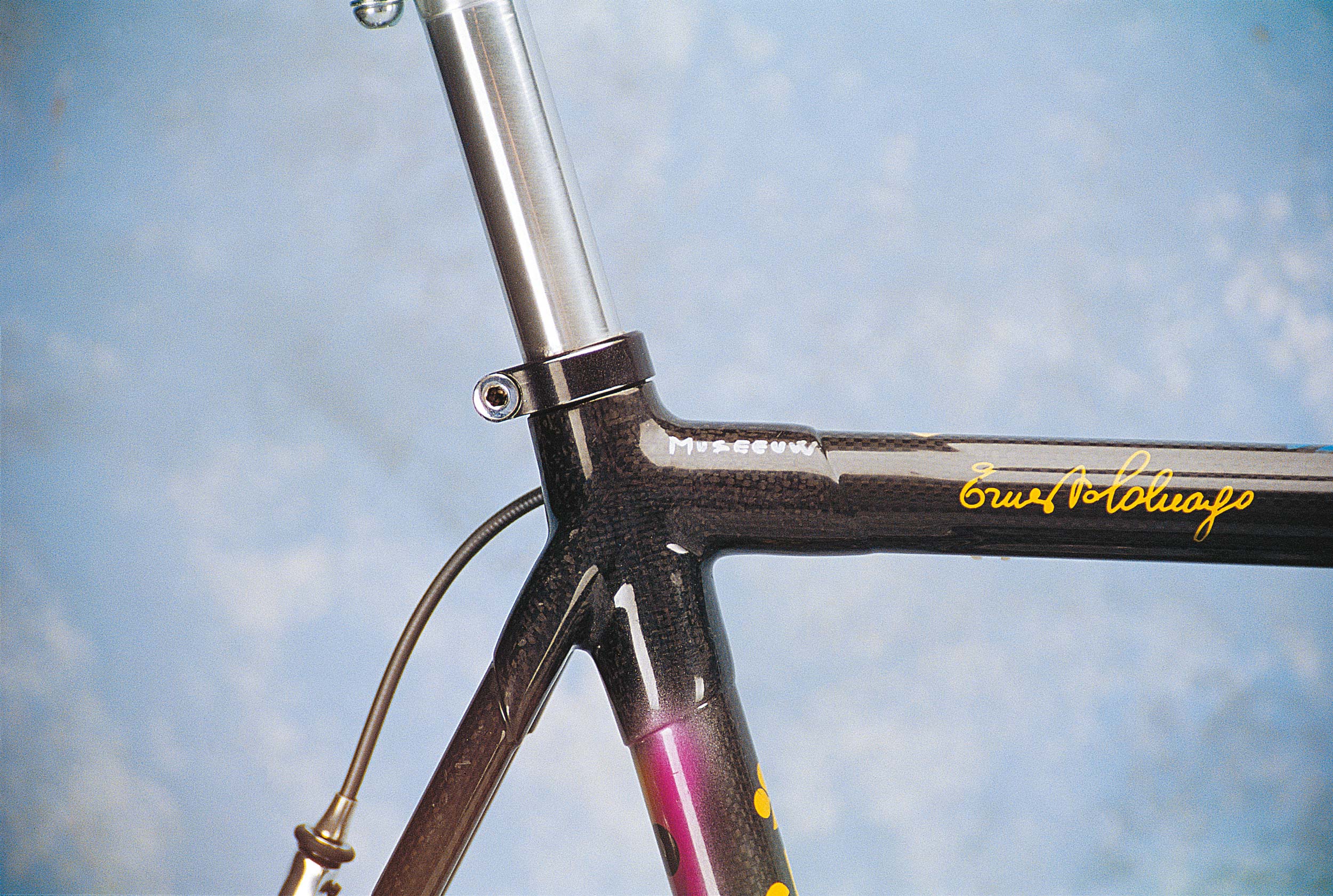
The seat lug on Mapei’s 1996 team bikes was modified to accommodate the 27.2mm aluminium Dura-Ace seatpost, the use of which was insisted upon by a major sponsor of the Mapei-GB team, Shimano. Public issue C40 frames were equipped with Colnago branded seatposts in the annoyingly unique 28mm diameter.
Museeuw’s name is scribbled on the frame and looks more like the work of the mechanic than a graphic artist, as pro bikes are now labelled. “The tubes were made heavier and stiffer purely for Roubaix with much more carbon in the construction,” said the rider when asked about any modifications that were made. “Remember it was the beginning of the carbon era and the C40 was a massive improvement over the previous aluminium and titanium frames I had been riding.
“The top tube length matched my standard frame, which meant that the distance to the bars was the same, but the wheelbase was longer. That way it is more comfortable and more stable over the cobbles. All the contact points — saddle, bars and pedals — were exactly the same as normal.”
Words: Warren Meade • Photos: Yuzuru Sunada
Johan Museeuw had his first taste of victory in the elite ranks in 1990 in the Tour de France. He won two stages: the first on Mont-Saint-Michel, the next in Paris – a monastery and then the famed cobbles of the Champs-Elysées. But it was on the pavé of the Classics that he achieved his greatest triumphs.
In a successful career spanning 14 years, the Flemish rider witnessed first-hand the transformation of bicycle frame technology. Being one of the most prominent riders of his generation he was privileged to test, in real world conditions, a multitude of different bikes made from various materials: steel, aluminium, titanium and carbon-fibre.
By 1996 Museeuw was riding for the world’s number one team, Mapei-GB. He was the World Cup winner from the previous year and was in amazingly good company at Mapei.
The squad had so many talented riders that it was even able to field three top quality teams in different corners of the globe simultaneously. Amongst the other stars in the team were Abraham Olano, the reigning world champion, and the current world hour record holder, Tony Rominger.
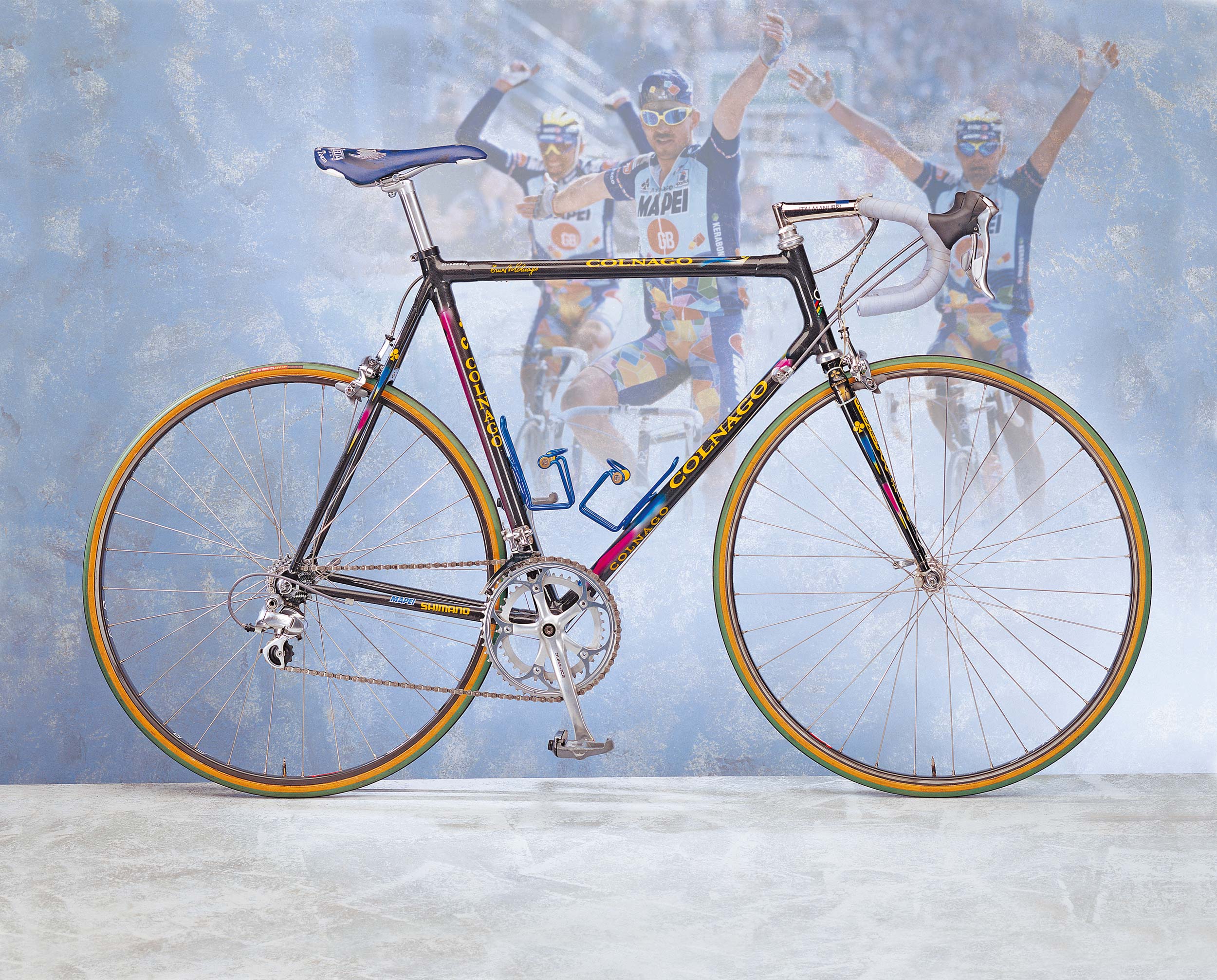
A classic for the Classics… Not overtly ‘carbon’, the 1996 version of the C40 — with its lugged construction, straight-bladed steel fork and quill stem — from a distance looks much like its lugged steel forebears.
Mapei-GB riders used Colnago’s flagship carbon C40 frames during 1996, but a quick glance at the bikes used by the team for the previous couple of years reveals the diversity of equipment at its disposal. It was also a great example of the rapid changes in technology being explored at the time.
Rominger had held the hour record since November 1994, at an incredible 55.291km. He rode a specially built Colnago, constructed of Columbus Oval CX steel tubing. This was teardrop shaped for maximum aerodynamics, not oval at all, and had been around since the early 1980s. A piece of trivia: Rominger covered the first 40km in a tad over 43 minutes on the way to his record.
Abraham Olano won the 1995 world championship road race on another Colnago (crossing the line with a punctured rear tyre). His particular frame was made of titanium, sporting the innovative ‘twin lateral’ down tubes. Christened the ‘Bi Titan’ by Colnago, it was produced in limited numbers. Its future prospects were good with a world championship achieved on this unique design, but it was displaced in the marketplace by the C40 before it had a chance to shine.
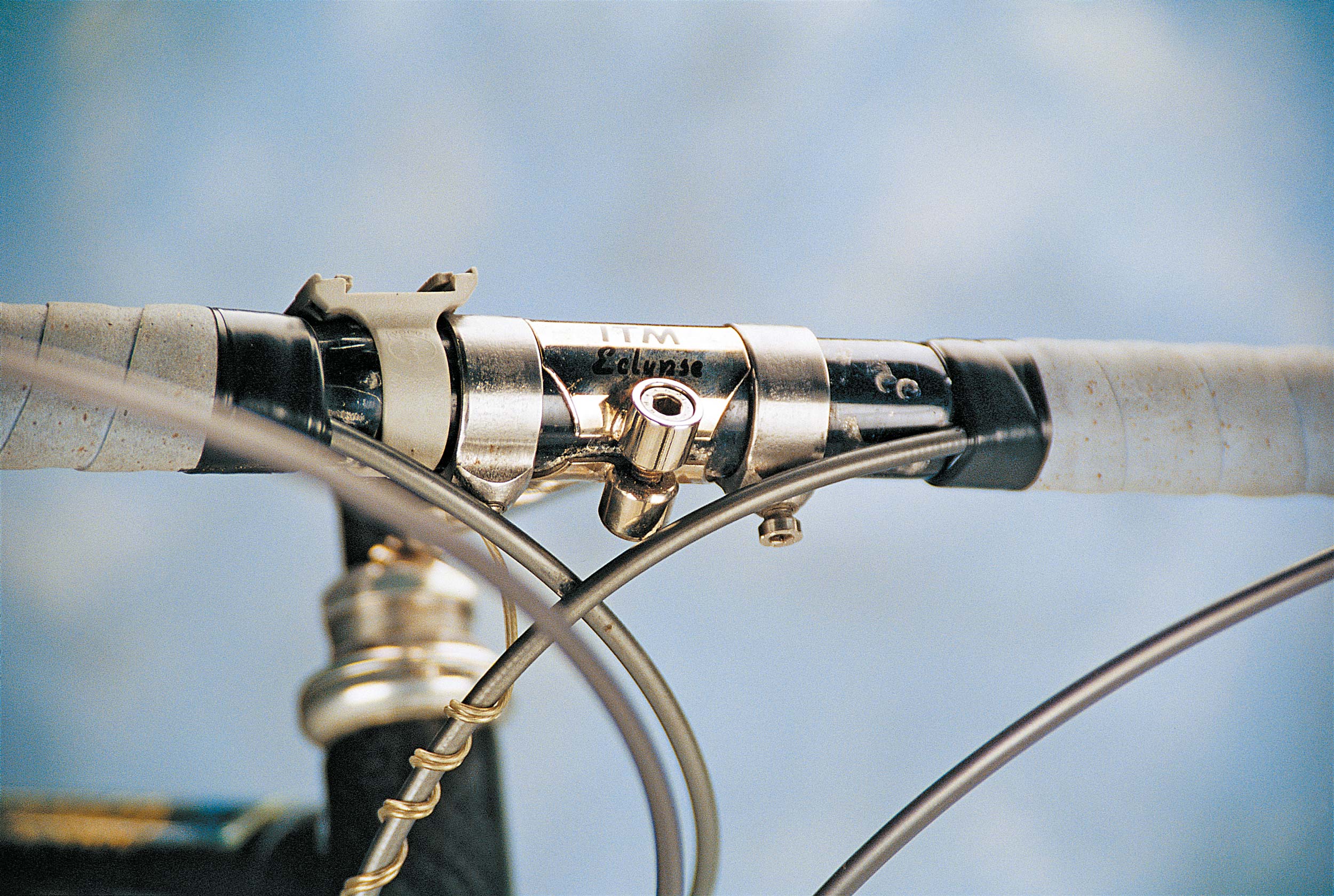
The ITM Eclipse stem was made from chromoly steel which was then nickel plated and matched to the ITM aluminium handlebars. Both withstood the extraordinary punishment of the brutal contest of Paris-Roubaix without problem.
The 1995 Paris-Roubaix had been won by another Mapei rider, Franco Ballerini, with his team filling four places in the top 10. The Italian had started the event on a steel framed Colnago but swapped to a carbon model early in the race and rode it for the rest of the day. Museeuw finished third, mounted on the steel frame he started the race on. More about this bike later… but in 1995, much of the field was on road bikes equipped with suspension, with 18 of the 24 teams fitting their bikes with special Rock Shox forks.

Gilbert Duclos-Lasalle was the first rider to use a suspension fork to win Paris-Roubaix. The French veteran beat Franco Ballerini (who used a standard steel fork) in 1993 by the width of a tyre.
Before the start a downcast Museeuw was quoted as saying that a rider without suspension was “at a disadvantage of 40 per cent”.
His bike supplier, Ernesto Colnago, had personally insisted on the team riding bikes with his straight-bladed Precisa steel fork.
Having been introduced in 1987, Colnago’s marketing men were still heavily promoting the straight blades for all their models. Even the carbon C40 frames were equipped with these steel forks as standard.
History shows that Museeuw’s statement was not justified as his result and Ballerini’s victory, without the aid of suspension, vindicated Ernesto’s judgment.
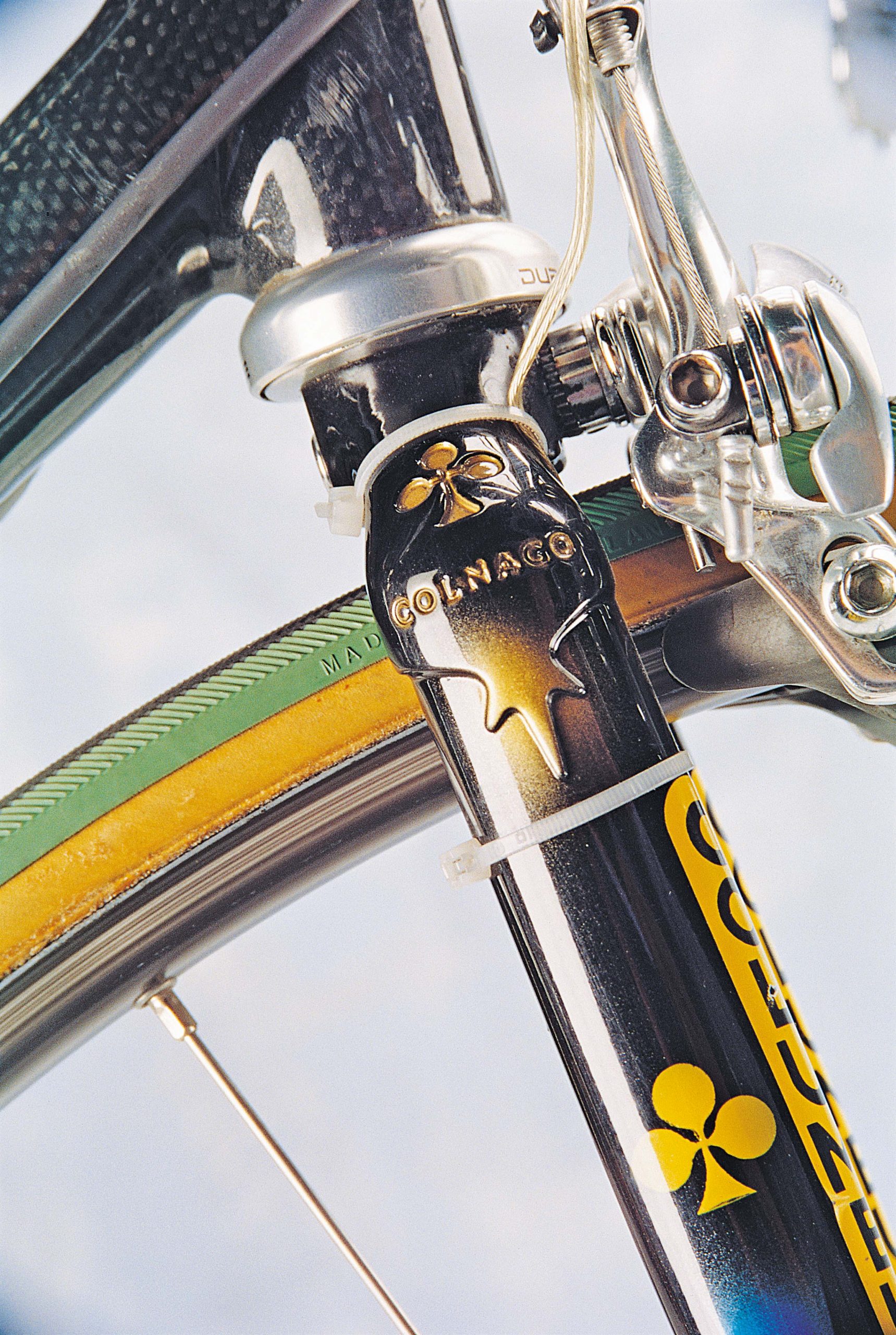
The Colnago Precisa steel fork was introduced in 1987 and it featured in the manufacturer’s catalogue right through to the carbon frames of the 1990s. The required four degree offset is designed into the fork crown, the theory being that the straight blades allow sufficient vertical compliance while improving lateral rigidity compared with the more traditional curved blades. The intricate detail of the fork crown casting is typical of Colnago’s attention to aesthetics, even if it weighs a few grams more.
While Museeuw’s 1995 Paris-Roubaix bike did not have suspension, it was quite different to his normal steel road bike and to Ballerini’s carbon model. It was, in fact, a steel cyclo-cross bike, equipped with the cantilever brakes and bar-end shifters unique to this off-road branch of our sport.
Museeuw had been an excellent practitioner of cyclo-cross and was quite at home on this machine with its longer wheelbase and laid-back angles.
Cyclo-cross bikes are also built with extra clearance for the knobby tyres used on the muddy courses, so they are ideal for the larger than normal tyres used for Paris-Roubaix. When these larger tyres were used in a normal road frame with tight clearance, they were prone to getting clogged with mud. When it rains at Paris-Roubaix, mud is the riders’ number-one enemy.
Bar-end shifters were also a sensible choice. If the rear derailleur was knocked out of adjustment in a fall or a rear wheel with different cassette spacing was put in following a puncture, the shifter could be switched back to ‘friction’ mode and the rider could continue on without having to swap bikes.
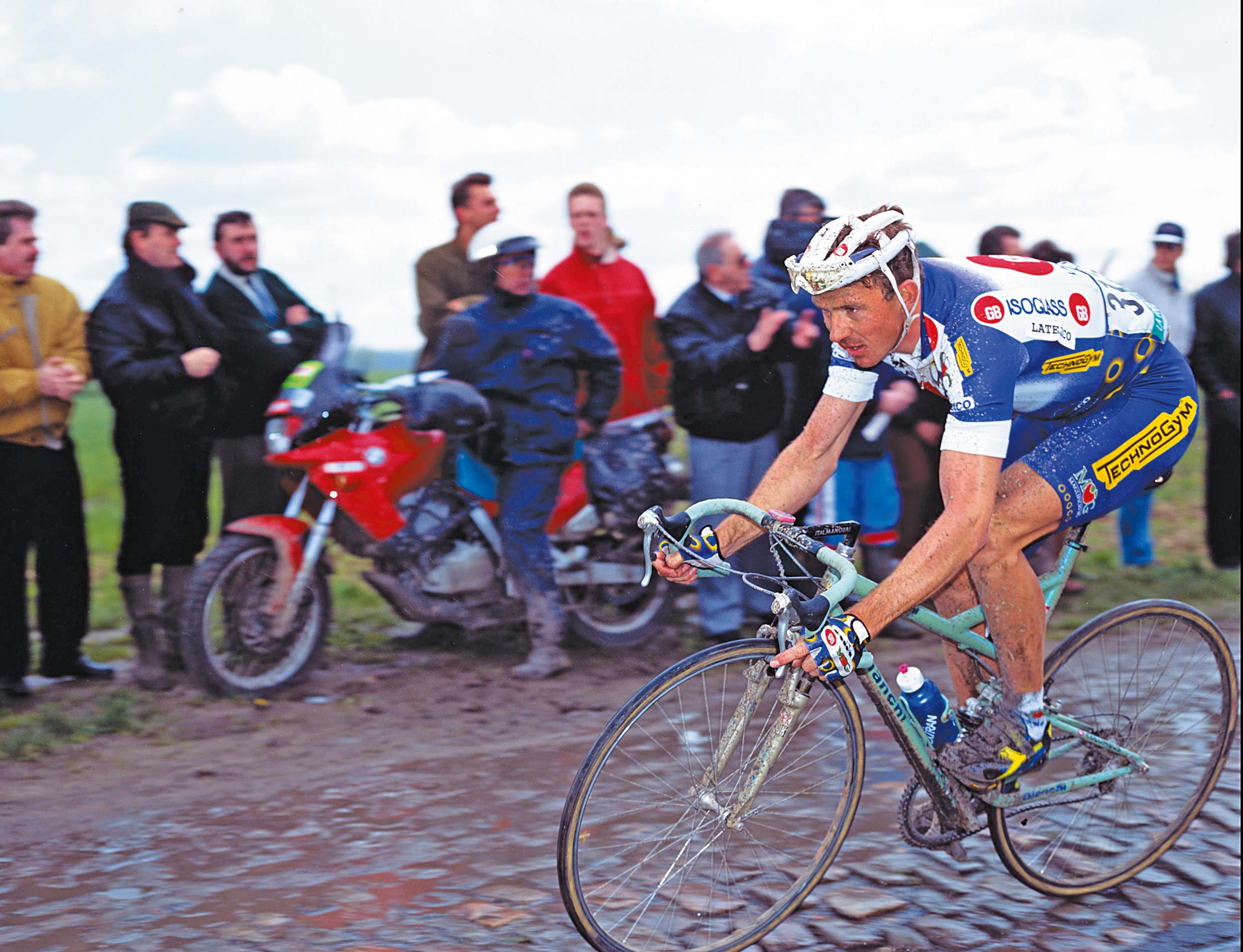
Almost in reaction to ‘Duclos’ and his Rock Shox triumph, Bianchi developed a special dual suspension frame for Museeuw and one of his team-mates to use in 1994. The bike didn’t receive a glowing appraisal from the rider and it’s even rumoured to have broken before he reached the Roubaix velodrome in 13th place.
Museeuw could be forgiven for thinking that he was at a severe disadvantage without suspension in 1995. The previous three editions of Paris-Roubaix had been won using Rock Shox. Gilbert Duclos-Lasalle won with the fork fitted to LeMond frames in 1992 and 1993, while Andrei Tchmil had his Caloi bike so equipped for his victory in 1994.
On the day Tchmil won in attrocious conditions, Museeuw was perched on a dual-suspension Bianchi for his 13th place. Two of the experimental suspension Bianchi frames were used, the other being trialled by Museeuw’s team-mate Carlo Bomans, but both frames apparently cracked before the race was over.
Museeuw reported that he did not like the rear suspension, saying that power loss on the sealed sections was too great to be offset by the comfort and control gained on the cobbles, which make up less than a quarter of the race distance. But the results of front suspension systems seemed to speak for themselves, so anyone not so equipped would have felt vulnerable.
* * * * *
The 1996 Colnago C40
Our feature bike is a standard issue Colnago C40 fitted with eight-speed Dura-Ace parts. At the same time in early 1996, nine-speed Shimano groupsets were being tested by some riders, including Mapei’s Olano, with the upgraded group being cited for release in September of that year. Released they were, but by early 1997 only 500 nine-speed ensembles had been made available to the European market and all had been well and truly presold.
The shortage was assumed to be due to the more complicated production techniques involved in making the new ‘hollow’ cranks.
Despite the extra cog, the nine-speed Dura-Ace group weighed 500 grams less than its eight-speed predecessor, a significant decrease in percentage terms.
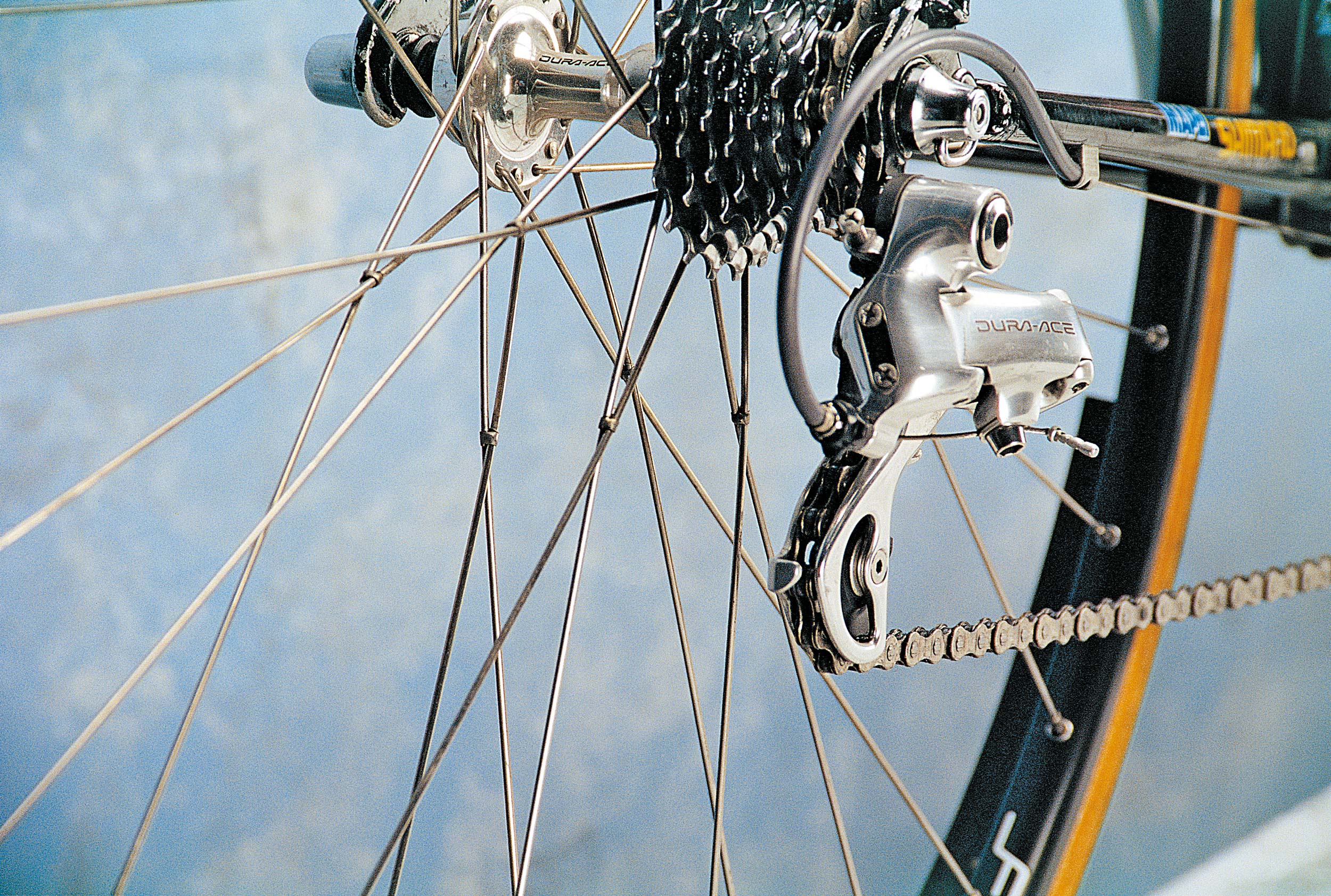
The Dura-Ace drivetrain was well proven by 1996. The hubs ran perfectly on simple, adjustable cup and cone bearings. The steel cassette body lasted forever without being damaged by the seat of the cogs. You can run 10 cogs on these old eight-speed hubs and clock up impressive kilometre counts without failure.
The Colnago C40 frame was first released in 1994. The name marked the 40th anniversary of Ernesto Colnago’s entry into the bicycle business.
Colnago marketed its flagship carbon model alongside steel, aluminium and titanium options in 1996.
Even though the Mapei team was supposed to be riding the carbon C40s throughout the year, there were many sightings of riders on other models in training and racing.
The carbon-fibre C40 is now considered a classic. Back in 1996, however, there were still many people looking at composite frames with scepticism. Steel and aluminium frames endured death by a thousand cuts; each time a rider won a major event on a carbon frame another wound was inflicted in the prospects of the more traditional materials.
Victories in the major races by Mapei riders mounted on C40s were important to the acceptance of carbon as a legitimate frame material. While Colnago was by no means a pioneer in the use of composite technology in the pro peloton, its well publicised successes using the material certainly helped to win over the traditionalists.
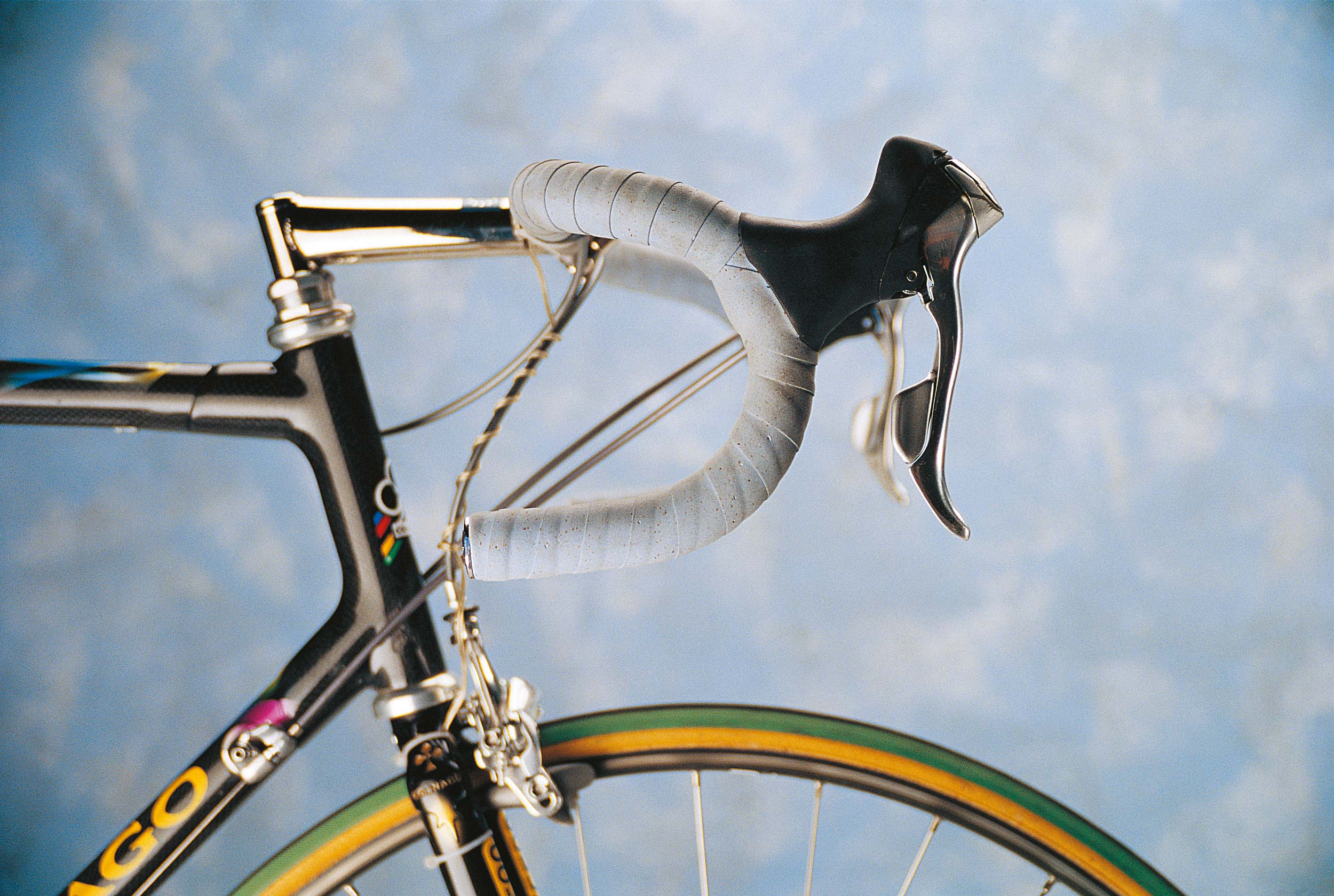
The ITM stem profile is pure cycle art, but the quill style configuration was on its last legs in 1996. This fastening system was soon to be superseded by the lighter and simpler Ahead system.
The early C40 frames weighed about 1,400g (depending on size), no lightweight by today’s standards but noteworthy 12 years ago.
With the eight-speed Dura-Ace groupset and steel fork, the bike tipped the scales at just under eight kilograms. Only 10 years earlier the average professional level race bike had weighed slightly under 10kg while 10 years later, in 2006, most pro bikes were just under the seven kilo mark.
Colnago used the lugged carbon construction technique. This enabled the relatively easy production of a multitude of sizes. The frames used tubing profiles similar to the steel, aluminium and titanium Colnago designs, once again aiding their acceptance into the mainstream.
The C40’s use of the traditional one inch steering tube in the fork and the quill stem was another reason it looked much like good bikes had looked for the previous 50 years.
This celebrated frameset underwent constant development, with the addition of a carbon fork, the Ahead-set style of stem and threadless steering tube, and the eventual official release of the upgraded C40 ‘B-Stay’ model in 2001.
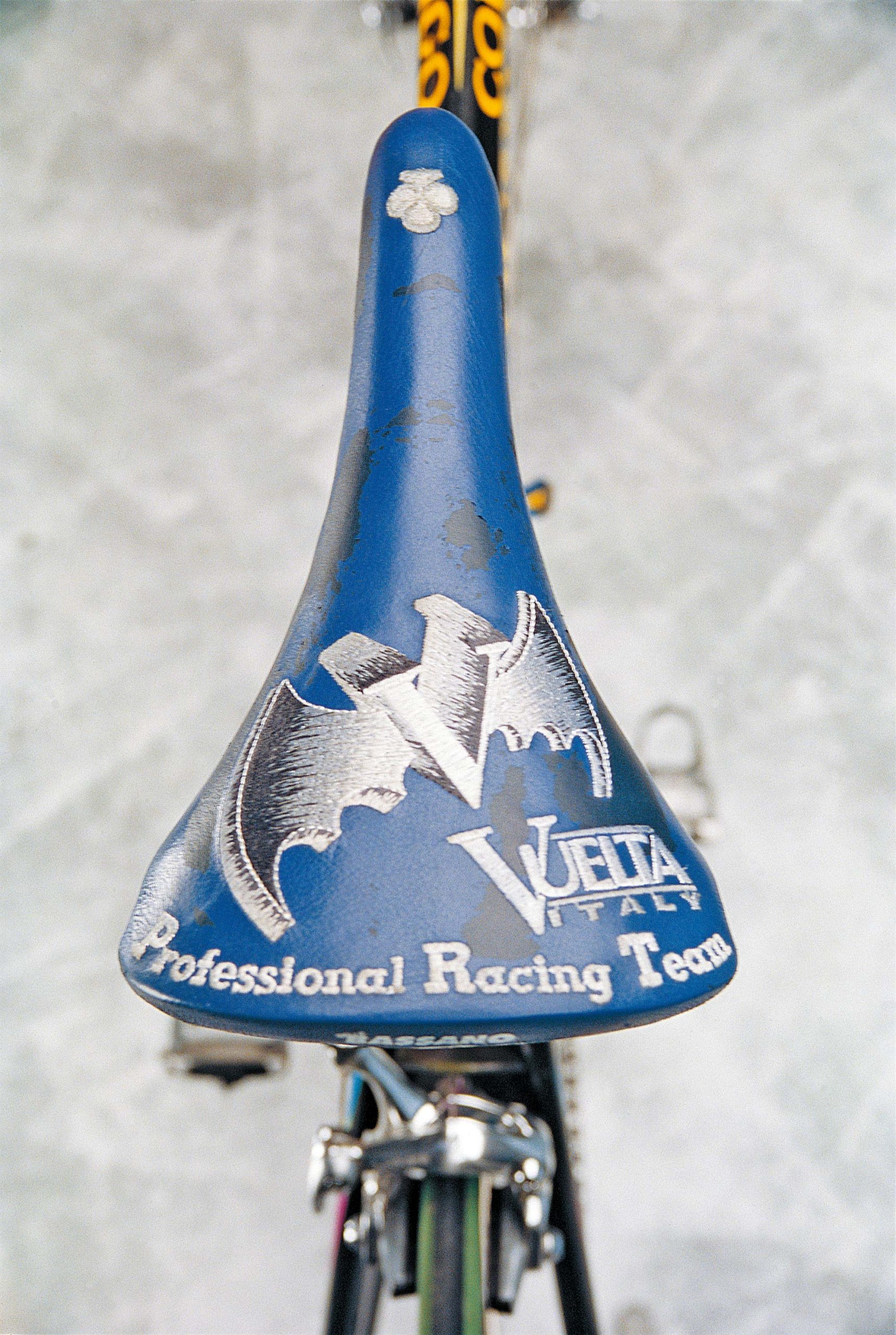
Selle Bassano was the official supplier of saddles to Mapei-GB. Intricately embroidered patterns were a feature of seats in the 1990s. Weight is more of an issue now than it was back then when riders would opt for comfort above all else. Even today it’s common for pro cyclists to use saddles that are branded as a model that the sponsor wants to promote when, in fact, the base is that of the user’s prefered shape.
By the time the new Colnago C50 was unveiled in 2003, carbon-fibre was the accepted high-end frame material in the bicycle industry. Traditional aesthetics could be deviated from and the best attributes of carbon-fibre construction embraced without offending the eyes of the consumers.
For the new model tube diameters increased markedly, the industry standard one and 1/8-inch steering tube was added to the Colnago ‘Force’ carbon fork, and the unique HP (High Power) chainstays were adopted.
* * * * *

Johan Museeuw leads Gianluca Bortolami and Andrea Tafi over the finish line for a memorable – and particularly controversial – victory in the 100th edition of Paris-Roubaix.
Memories of Paris-Roubaix in 1996
In 1996 the 100th anniversary of Paris-Roubaix brought one of the most memorable results ever for a cycling team in a one-day Classic. Already the dominant team of the era, the Italian owned Mapei-GB squad set out to put one of its star riders on the podium, although the final result saw the podium monopolised by the team’s colours.
As team leader, Museeuw won the 1996 Paris-Roubaix, leading Mapei’s exclusive three-man escape group across the line.
The photos of Museeuw, Gianluca Bortolami and Andrea Tafi crossing the line together are amongst the most famous in our sport. The myriad versions of the story of how they sorted out the finishing order have kept journalists and fans well occupied since, and probably will for many years to come.
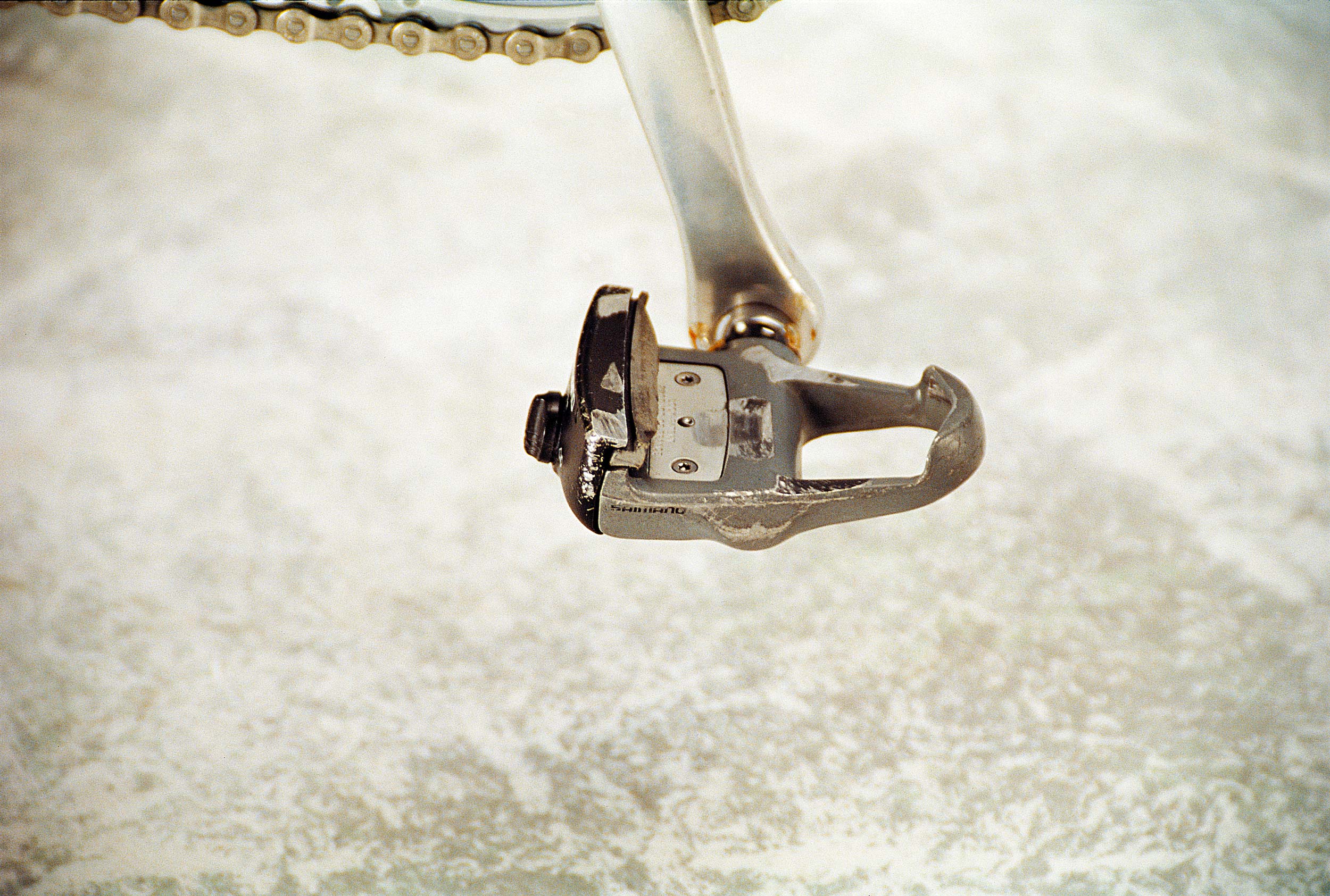
The Look patent clipless pedals, made under licence by Shimano, were the preferred option of many pro riders, despite the existence of Shimano’s own design. Lance Armstrong insisted on using this style for many years until the current configuration was released.
The cranks look positively petite, especially when compared with the current Dura-Ace design.
“I always used a shorter crank for Roubaix,” said Museeuw, “172.5mm instead of my usual 175.5mm. The cassette I used in Paris-Roubaix was 11-21 but at the front the chainrings were always the same: 52/46.”
The focus of our retro features is on the machines, and this most emphatic result by the Mapei men on their Colnago C40s not only reinforced Colnago’s position in the market place, it boosted the acceptance of carbon in the eyes of rival frame manufacturers and the public alike.
Later in 1996, Museeuw put the icing on his season’s cake by winning the Belgian national title followed by the world championship in Lugano, Switzerland. Along the way he amassed enough points to take out the season-long World Cup title, for the second year running.
Museeuw went on to win Paris-Roubaix for a second time in 2000, then again in 2002, by which time he was the ripe old age of 36. Younger so-called ‘veteran’ club racers take note. The ‘Lion of Flanders’ retired in 2004. Befitting his legend status – and like many of his legendary predecessors – he now markets his own brand of Museeuw bicycles.
– By Warren Meade


